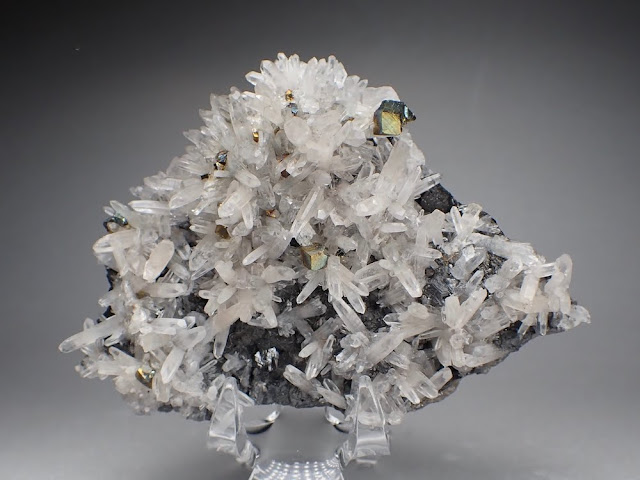尾太の水晶と黄銅鉱 Quartz and Chalcopyrite from Oppu
幅 width 8 cm / 重さ weight 129 g
閃亜鉛鉱の板状の塊の上に長さ 8 mm ほどの小さな水晶が群生し、その合間に最大 5 mm の黄銅鉱が散点する。なんてことのない鉱脈中の晶洞の鉱片だが、注目すべきは黄銅鉱の結晶の形だ。とくに最大サイズの結晶はほぼ四周完全な菱形十二面体で、古典的な面記号でいうと m(110) と e(101) とがほぼ等大に発達したものである。他の小さい結晶もほぼ同様。条線がみられるが、これは p(111) の面がちょっとだけあらわれて段々になったものだ。
Several chalcopyrite crystals to 5 mm in size are scattered on a quartz cluster that grows from a tabular matrix of sphalerite. Of particular interest is that chalcopyrite exhibits an almost complete rhombic dodecahedron composed of m(110) and e(101) surfaces. A number of p(111) surfaces appear a little to form striation.
The front shining surface is m(110). This shape is common in garnet but rare in chalcopyrite.
Other smaller crystals exhibit similar dodecahedron.
おもうに、このような平らな教科書どおりの結晶面で囲まれる黄銅鉱の単結晶は、ある程度の大きさのになるときわめて稀である。行きつけの東京・白山の店でこの標本をみつけたとき、黄銅鉱大好きのわたしは興奮がとまらなかった。前に紹介したペルー・ティクリオ鉱山の例や、三角式黄銅鉱の例と同様、鉱化作用の最終段階で石英とともに少量だけ晶出するとき、こうした教科書どおりの結晶面で囲まれた単結晶ができやすい、というのは一般的な現象なのだろう。この尾太の例では m(110) 面がきれいに出ているのがおもしろい。というのも m 面は三角式黄銅鉱を特徴づける面だから。この標本ももうちょっとがんばったら(?)三角式黄銅鉱になれたかもしれない。
I think that it is rare to see an example of chalcopyrite crystal enclosed with flat simple surfaces as explained in textbooks. I was excited by finding this specimen at a shop in Hakusan, Tokyo. It would be a general phenomenon that such a simple chalcopyrite crystal tends to be created in the final stage of ore forming processes with quartz, as is seen in the examples of the Peruvian specimen and triangular chalcopyrite. It is interesting that m(110) surfaces appear in this piece, for that surface characterizes triangular chalcopyrite.
参考
-
和田維四郎「日本鉱物誌第2版」より。十二面体の黄銅鉱結晶といっても x(113) と Y(311) とからなるもの(図11; いわゆる三方四面体)、χ(212) と t(221) とからなるもの(図12)、y(313) と X(331) とからなるもの(図13)などいろいろある。ちなみに太良とは尾太から南に約 10 km ほどの白神山地の秋田県側に位置する鉱山で、方鉛鉱の巨晶が有名。足尾 → 尾太 → 太良ってしりとりできる。
From Wada's Minerals of Japan, 2nd edition. There are several types of dodecahedral chalcopyrite such as x(113) + Y(311), χ(212) + t(221), and y(313) + X(331).
-
smorf で描いた結晶図。ちなみに黄銅鉱 CuFeS2 は正方晶系に属し a : c = 1 : 1.97 であるが、仮に銅原子と鉄原子とを同一視すると閃亜鉛鉱型構造にほぼ等しく、その単位格子は立方晶の閃亜鉛鉱の単位格子を2つ並べたものと理解できる。よって黄銅鉱を a : c = 1 : 1.97 ÷ 2 = 1 : 0.985 という c 軸方向にちょっとつぶれた擬立方晶と考えることもできる。昔の文献をみると、厳密には e(102) と書くべきところを、よりわかりやすく e(101) と表記しており、本文でもその流儀に従った。
-
(2020年7月15日追記)加藤昭「硫化鉱物読本」(関東鉱物同好会、1999年)という本をおなじ白山のお店でさいきん手に入れた。そこに「(黄銅鉱の)良晶の集合は、生成に関与した元素の種類が単純な場合に多く、硫塩(鉱物)は余り出現しない」とあった。




